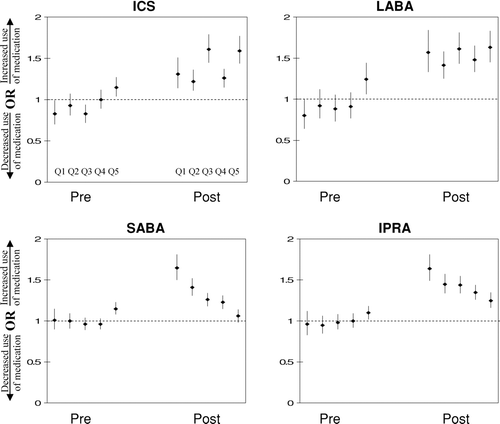Figures & data
Table 1 Patient characteristics stratified by the probability of having had spirometry performed and use of spirometry
Table 2 Patients receiving medications before and after the index date
Figure 1 Adjusted odds ratios of medication use one year prior to (Pre) and after (Post) the index date for those who have ever had a spirometry 720 days prior to 180 days after the index date for quintiles one to five, from left to right. Quintile 1 is the group with the least probability of having spirometry. ICS = inhaled corticosteroid; LABA = long-acting beta agonist; SABA = short-actiing berta agonist; IPRA = ipratropium; Q = quintile. The logistic regression models (LRM) were adjusted for the following unbalanced covariates. Quintile one: age, marital status, depression, mental health, alcohol abuse, cancer, primary care, emergency department, and hospital contacts. Quintile two: age, emergency department and hospital contacts. Quintile three was balanced. Quintile four: age, heart disease, substance abuse, and primary care contacts. Quintile five: age, marital status, asthma, hypertension, alcohol abuse, substance abuse, primary care and pulmonary contacts. The LRM for medication use after the index date was also adjusted for medications prior to the index date if not balanced within the propensity scores quintiles. These included ICS, LABA and no medication use in quintile one, ICS in quintile three, and ICS, LABA, SABA, IPRA and no medication use in quintile five.

Figure 2 Adjusted odds ratios for adding (Add) and discontinuing (Drop) medications for those who have ever had a spirometry 720 days prior to 180 days after the index date for quintiles one to five, from left to right. Quintile 1 is the group with the least probability of having spirometry. ICS = inhaled corticosteroid; LABA = long-acting beta agonist; SABA = short-actiing beta agonist; IPRA = ipratropium; Q = quintile. The logistic regression models were adjusted for the unbalanced covariates. (Same as in except for medications).
